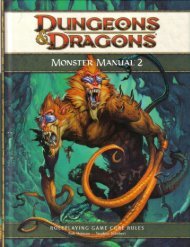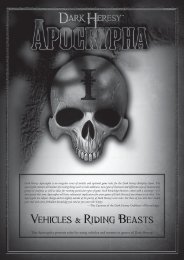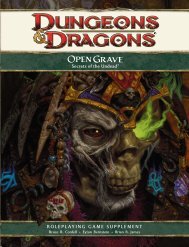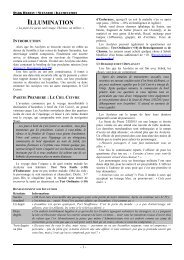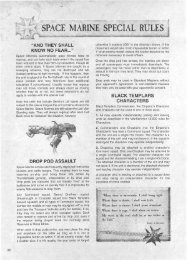You also want an ePaper? Increase the reach of your titles
YUMPU automatically turns print PDFs into web optimized ePapers that Google loves.
thrill or challenge for the chase. Grays subsist almostentirely on a diet of humanoids that are intelligent ordangerous enough to provide at least the semblanceof a contest.A gray dragon prefers to stay aloft during a fight.From the air, it uses its breath weapon and attacks withreach, riveting foes with rocky spikes from tail andclaws. If one or more opponents take to the air toclose with the dragon, the gray either focuses all itsattacks on one or two brave flyers or, if three or moreattackers have taken wing, beats a hasty retreat forthe horizon to seek easier prey. Although gray <strong>dragons</strong>enjoy the hunt, they are less keen on fair fightsagainst truly dangerous foes.trophies of glorious successes. Even though gray<strong>dragons</strong> do not value treasure for its own sake to theextent that other <strong>dragons</strong> do, grays nevertheless takestrong measures to protect their keepsakes.Life CycleA gray dragon lays its eggs after about four months,for a total incubation time of twenty months. A clutchnumbers one to two eggs, all of which prove viableunder optimal conditions.A gray dragon is a wyrmling until about theage of ten and is young until nearly age 200. Itbecomes an elder at around 900 years and anancient around 1,400. The oldest confirmed36Lairs and TerrainGray <strong>dragons</strong> prefer badlands, scrubland, dry prairies,and other clear terrain over terrain that containsvisual obstructions. They like to see potential quarryfor miles around as they ride high thermals likegigantic birds of prey. A gray can see the tiniest movementacross a plain and might dance from thermal tothermal for hours to bridge the gap to a distant thingit wants to investigate.A gray dragon might establish a temporary lairwhile on an extended hunt in a region far from itspermanent lair. Such a simple outpost gives the graya place to sleep, a place to eat its catch, and a place tostore any treasure destined for its main hoard. Grayslocate these outposts on mountain ledges or in similarlocations accessible only by air. The <strong>dragons</strong> leavesuch lairs unguarded, returning each night to feast onthe fruits of their hunts.A gray dragon’s home lair might stand abandonedfor weeks or months at a time, so before it leaves on ahunt the dragon seals the lair’s central chamber withan avalanche of boulders and petrified victims.Favored TreasureGray <strong>dragons</strong> do not prefer any type of treasure overany other type. Their hoards typically consist of itemstaken from the victims of past hunts: mementos andCHAPTER 1 | Dragon Loreage any gray dragon has reached is approximately2,100 years.When a gray dragon dies, it petrifies, becominga spiky outcropping with an uncannily draconicshape. When a deceased gray dragon experiencesenvironmental diffusion, the result is an area ofabnormal aridity. Streams running through thearea dry up, as do wells. Any creature that spendsmore than an hour in the area becomes parched,and water stored in containers somehowdisappears.Physical CharacteristicsStony spikes stud gray <strong>dragons</strong>’ scales andlimbs. A gray’s spikes can detach, allowingit to pin potential prey to the earth with theappropriate attack.A gray’s scales range from limestone whiteto granite gray, serving as excellent camouflagein the dragon’s preferred terrain. As theOPTIONAL RULEDue to its exceptional eyesight, a gray dragon takes only a–4 penalty to attack rolls, rather than –5, when attackinga target that has total concealment.SAM WOOD





